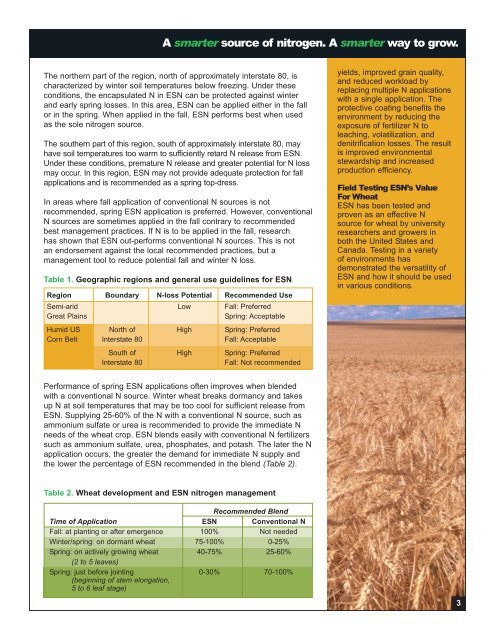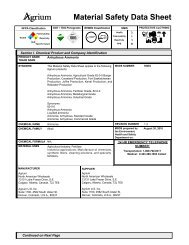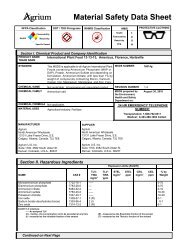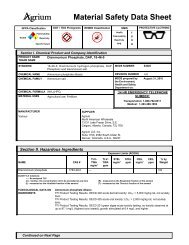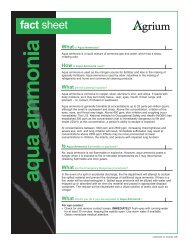ESN Wheat Fact Sheet 0408.qxp - Agrium Wholesale
ESN Wheat Fact Sheet 0408.qxp - Agrium Wholesale
ESN Wheat Fact Sheet 0408.qxp - Agrium Wholesale
Create successful ePaper yourself
Turn your PDF publications into a flip-book with our unique Google optimized e-Paper software.
A smarter source of nitrogen. A smarter way to grow.<br />
The northern part of the region, north of approximately interstate 80, is<br />
characterized by winter soil temperatures below freezing. Under these<br />
conditions, the encapsulated N in <strong>ESN</strong> can be protected against winter<br />
and early spring losses. In this area, <strong>ESN</strong> can be applied either in the fall<br />
or in the spring. When applied in the fall, <strong>ESN</strong> performs best when used<br />
as the sole nitrogen source.<br />
The southern part of this region, south of approximately interstate 80, may<br />
have soil temperatures too warm to sufficiently retard N release from <strong>ESN</strong>.<br />
Under these conditions, premature N release and greater potential for N loss<br />
may occur. In this region, <strong>ESN</strong> may not provide adequate protection for fall<br />
applications and is recommended as a spring top-dress.<br />
In areas where fall application of conventional N sources is not<br />
recommended, spring <strong>ESN</strong> application is preferred. However, conventional<br />
N sources are sometimes applied in the fall contrary to recommended<br />
best management practices. If N is to be applied in the fall, research<br />
has shown that <strong>ESN</strong> out-performs conventional N sources. This is not<br />
an endorsement against the local recommended practices, but a<br />
management tool to reduce potential fall and winter N loss.<br />
Table 1. Geographic regions and general use guidelines for <strong>ESN</strong><br />
Region Boundary N-loss Potential Recommended Use<br />
Semi-arid Low Fall: Preferred<br />
Great Plains<br />
Spring: Acceptable<br />
Humid US North of High Spring: Preferred<br />
Corn Belt Interstate 80 Fall: Acceptable<br />
South of High Spring: Preferred<br />
Interstate 80<br />
Fall: Not recommended<br />
yields, improved grain quality,<br />
and reduced workload by<br />
replacing multiple N applications<br />
with a single application. The<br />
protective coating benefits the<br />
environment by reducing the<br />
exposure of fertilizer N to<br />
leaching, volatilization, and<br />
denitrification losses. The result<br />
is improved environmental<br />
stewardship and increased<br />
production efficiency.<br />
Field Testing <strong>ESN</strong>’s Value<br />
For <strong>Wheat</strong><br />
<strong>ESN</strong> has been tested and<br />
proven as an effective N<br />
source for wheat by university<br />
researchers and growers in<br />
both the United States and<br />
Canada. Testing in a variety<br />
of environments has<br />
demonstrated the versatility of<br />
<strong>ESN</strong> and how it should be used<br />
in various conditions.<br />
Performance of spring <strong>ESN</strong> applications often improves when blended<br />
with a conventional N source. Winter wheat breaks dormancy and takes<br />
up N at soil temperatures that may be too cool for sufficient release from<br />
<strong>ESN</strong>. Supplying 25-60% of the N with a conventional N source, such as<br />
ammonium sulfate or urea is recommended to provide the immediate N<br />
needs of the wheat crop. <strong>ESN</strong> blends easily with conventional N fertilizers<br />
such as ammonium sulfate, urea, phosphates, and potash. The later the N<br />
application occurs, the greater the demand for immediate N supply and<br />
the lower the percentage of <strong>ESN</strong> recommended in the blend (Table 2).<br />
Table 2. <strong>Wheat</strong> development and <strong>ESN</strong> nitrogen management<br />
Recommended Blend<br />
Time of Application <strong>ESN</strong> Conventional N<br />
Fall: at planting or after emergence 100% Not needed<br />
Winter/spring: on dormant wheat 75-100% 0-25%<br />
Spring: on actively growing wheat 40-75% 25-60%<br />
(2 to 5 leaves)<br />
Spring: just before jointing 0-30% 70-100%<br />
(beginning of stem elongation,<br />
5 to 6 leaf stage)<br />
3


